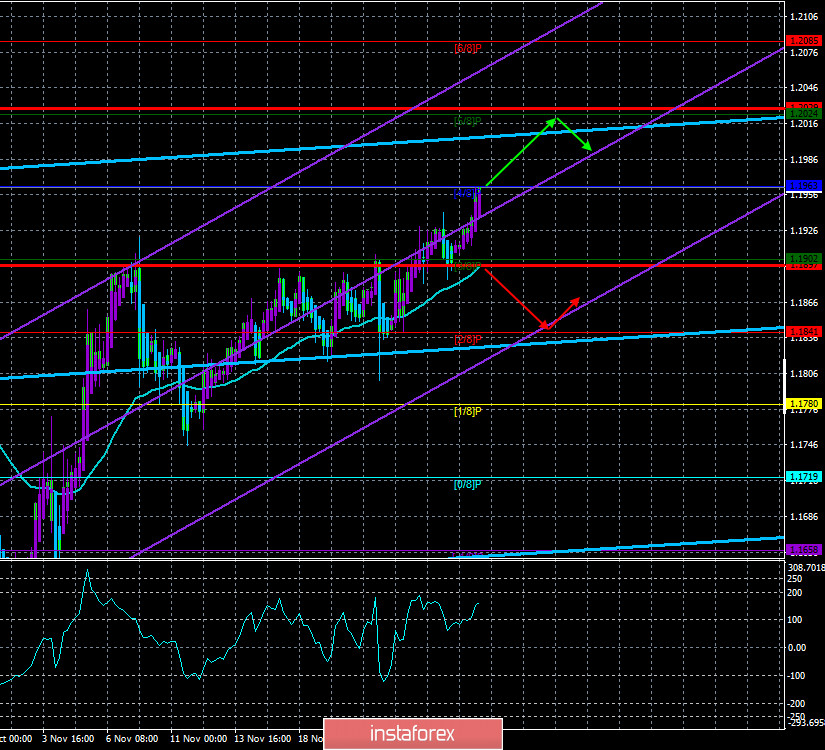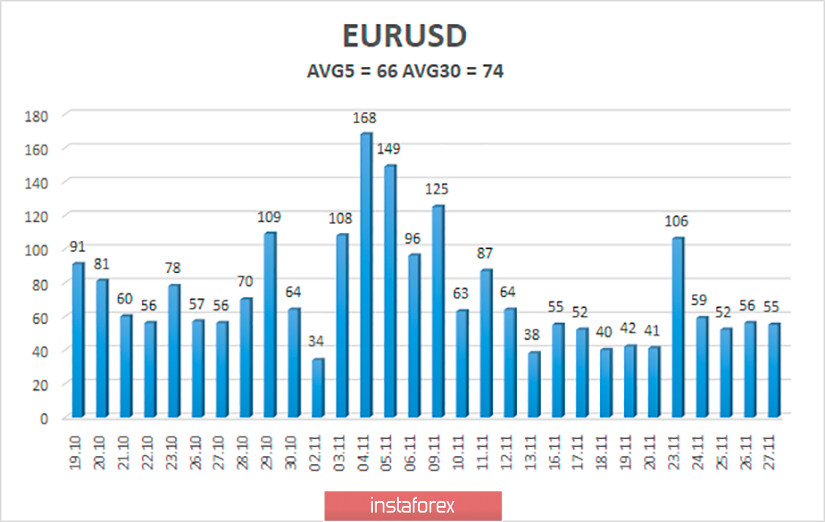4-hour timeframe

Technical details:
Higher linear regression channel: direction - sideways.
Lower linear regression channel: direction - upward.
Moving average (20; smoothed) - upward.
CCI: 164.1826
The fifth trading day for the EUR/USD pair was again in an upward movement. Although the volatility in recent weeks is quite low, as can be seen from the volatility table below, nevertheless, the upward movement is still quite stable. In recent weeks, we have repeatedly been surprised by the fact that the British pound is showing growth against the dollar. We have repeatedly said that there were no fundamental reasons for strengthening the pound. Now, it seems that the European currency has caught the same disease. At a time when America was overwhelmed by all sorts of crises, the US dollar simply could not rise in price, which was logical. During the US election period, when many were skeptical of the dollar, it simply did not become more expensive. Now, when the situation in the United States has more or less stabilized, the US dollar for some reason began to fall again. Now, even theoretically, it is difficult to find a reason why the US currency is under pressure. Of course, under democratic presidents, the US currency often becomes cheaper than more expensive. However, this is a long-term issue. It is unlikely that investors and traders rushed to get rid of the US currency as soon as they learned that the next president will be Joe Biden.
The most interesting thing is that only disappointing reports are coming from Europe right now. No, there is no outright negative. But at the same time, there is no positive. The EU has already faced the challenge of vetoing the seven-year budget and the post-pandemic recovery fund by Poland and Hungary. If at first, this problem did not seem to be a problem at all, because it is unlikely that the authorities of the EU and its two members could not agree. However, now, after some time, it becomes clear that a quick and painless agreement will not work. Warsaw and Budapest are demanding that the EU authorities review legislation that allows for cuts in funding from the general budget based on non-compliance with the rule of law directives. Recall that the problem is that Brussels accuses the Polish and Hungarian authorities of discrimination against political opponents, violations of the principle of democracy, and infringement of the rights of sexual minorities. The accused, on the other hand, believe that they have nothing wrong with democracy, and the proposed new legislation is proposed to force them to recognize same-sex marriages and accept refugees from the South. However, the EU's key accusation against Poland and Hungary is an attempt by local authorities to subdue the judicial systems. This violation, according to the EU, implies the development of corruption and, as a result, the theft of money from the European budget.
However, as political analysts say, Budapest and Warsaw are unlikely to get anything out of this political demarche. The problem is that at this time it is proposed to consider and vote for a package consisting of the budget, the recovery fund, and new legislation in its entirety. This requires the approval of all EU member states. However, in certain cases, the approval of 55% of EU countries (15 or more out of 27) is sufficient to pass a certain bill. For example, the issue of new legislation requires the approval of at least 15 countries of the alliance. And if consent is obtained, the bill will be passed, despite the protests of Poland and Hungary. Thus, Brussels and Berlin can now simply divide the package of bills and vote on each separately. Therefore, if the "rule of law mechanism" is adopted, Poland and Hungary can veto it as much as they want. They will only achieve this by blocking their access to the 2021-2027 budget and the recovery fund.
However, this also cannot be misunderstood in Warsaw and Budapest themselves. Lawyers from these countries probably know EU law and understand that if the alliance wants to adopt a new compliance mechanism, it will accept it. Accordingly, the purpose of vetoing can only be a "warning shot" to the European authorities. Warsaw and Budapest seem to show that if the "compliance mechanism" is adopted, then in the future they will block any other bills that require the unanimous approval of all EU member states. Thus, a conflict is brewing in the European Union and now it is not clear how it will end.
Negative economic news is also coming from the EU. Over the past two weeks, Christine Lagarde, the ECB President, has made five or six speeches, and each time her speeches have been very pessimistic. The head of the ECB noted several times that in December the ECB will expand the package of stimulus measures, that the EU economy will again begin to experience problems at the end of 2020 due to a new wave of pandemic and a new "lockdown". Thus, the EU's GDP is likely to contract again in the fourth quarter. Experts have already estimated that in the fourth quarter, the economy may lose about 3%. This is the kind of news that has been coming in from the EU recently. Let's return to the question that we asked at the beginning of the article: on what grounds is the euro currency growing now?
As we have said more than once, any currency can grow with absolutely any fundamental background. Just often, the fundamental background and the nature of the movement of a particular currency coincide. However, many patterns were broken in 2020. For example, for most of the year, market participants completely ignore macroeconomic statistics. Moreover, the pandemic has made adjustments in all areas. Thus, we are not personally surprised by the fact that the euro is now growing again. Before that, it had been standing in one place for 4 months, although the trader had reasons for more active trading. Therefore, we only remind you once again that any fundamental hypothesis requires technical confirmation.
From a technical point of view, the euro/dollar pair continues to move to the previous high just above $1.20. We still believe that there is nothing for the pair to do above this level. This is supported by both the COT and foundation reports. Nevertheless, the "technique" now remains on the side of the European currency and the bulls for the EUR/USD pair. Therefore, we continue to recommend trading higher.

The volatility of the euro/dollar currency pair as of November 30 is 66 points and is characterized as "average". Thus, we expect the pair to move today between the levels of 1.1897 and 1.2029. A reversal of the Heiken Ashi indicator downwards signals a round of corrective movement.
Nearest support levels:
S1 – 1.1902
S2 – 1.1841
S3 – 1.1780
Nearest resistance levels:
R1 – 1.1963
R2 – 1.2024
R3 – 1.2085
Trading recommendations:
The EUR/USD pair continues its upward movement. Thus, today it is recommended to stay in buy orders with the target of the Murray level of "5/8"-1.2024 until the Heiken Ashi indicator turns down. It is recommended to consider sell orders if the pair is fixed below the moving average with targets of 1.1841 and 1.1780.
 English
English 
 Русский
Русский Bahasa Indonesia
Bahasa Indonesia Bahasa Malay
Bahasa Malay ไทย
ไทย Español
Español Deutsch
Deutsch Български
Български Français
Français Tiếng Việt
Tiếng Việt 中文
中文 বাংলা
বাংলা हिन्दी
हिन्दी Čeština
Čeština Українська
Українська Română
Română

